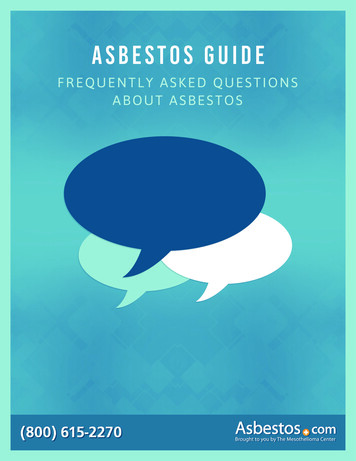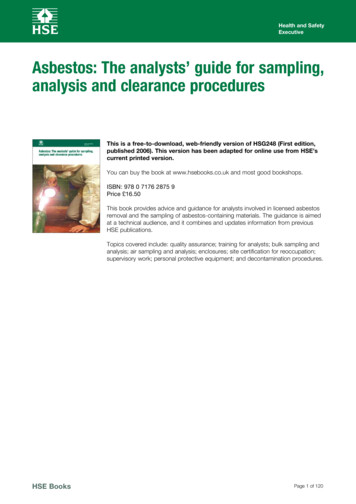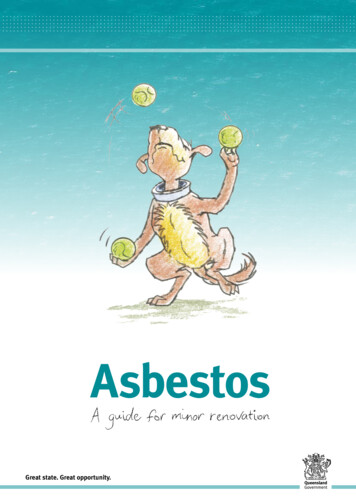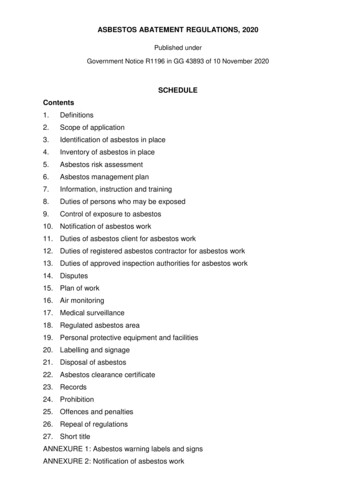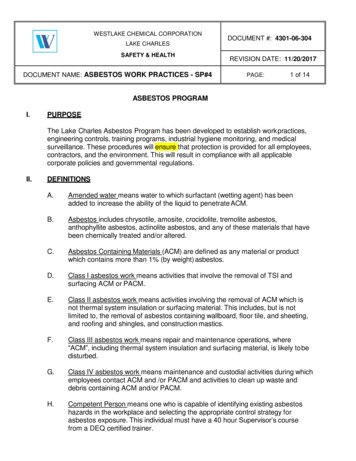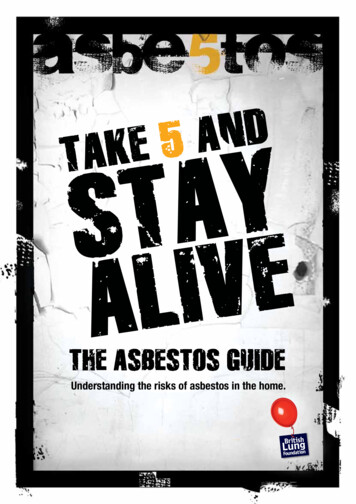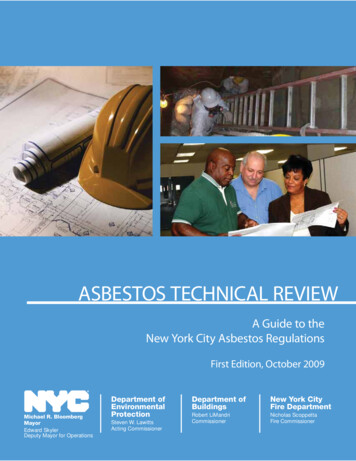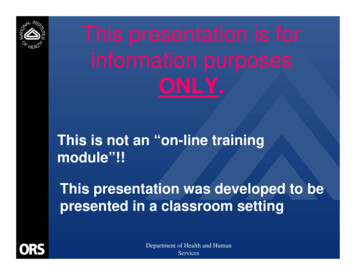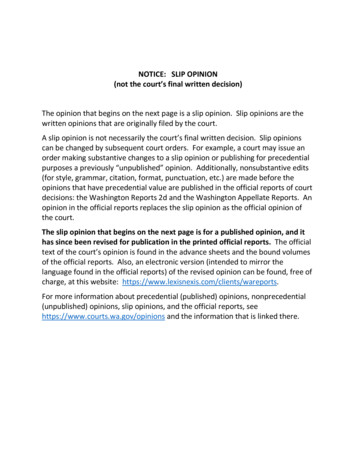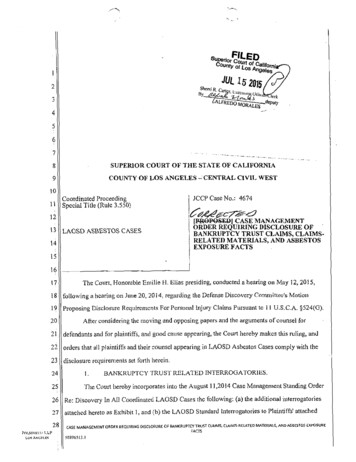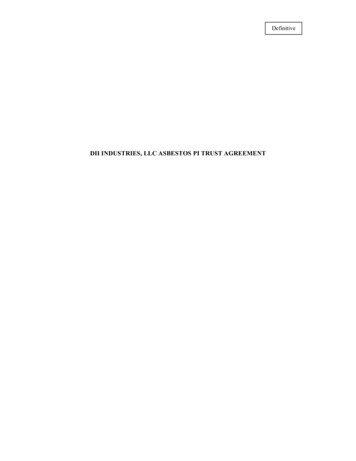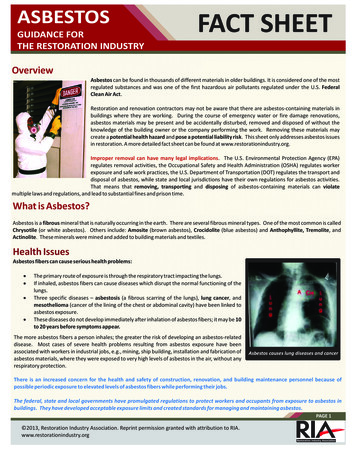
Transcription
ASBESTOSGUIDANCE FORTHE RESTORATION INDUSTRYFACT SHEETOverviewAsbestos can be found in thousands of different materials in older buildings. It is considered one of the mostregulated substances and was one of the first hazardous air pollutants regulated under the U.S. FederalClean Air Act.Restoration and renovation contractors may not be aware that there are asbestos-containing materials inbuildings where they are working. During the course of emergency water or fire damage renovations,asbestos materials may be present and be accidentally disturbed, removed and disposed of without theknowledge of the building owner or the company performing the work. Removing these materials maycreate a potential health hazard and pose a potential liability risk. This sheet only addresses asbestos issuesin restoration. A more detailed fact sheet can be found at www.restorationindustry.org.Improper removal can have many legal implications. The U.S. Environmental Protection Agency (EPA)regulates removal activities, the Occupational Safety and Health Administration (OSHA) regulates workerexposure and safe work practices, the U.S. Department of Transportation (DOT) regulates the transport anddisposal of asbestos, while state and local jurisdictions have their own regulations for asbestos activities.That means that removing, transporting and disposing of asbestos-containing materials can violatemultiple laws and regulations, and lead to substantial fines and prison time.What is Asbestos?Asbestos is a fibrous mineral that is naturally occurring in the earth. There are several fibrous mineral types. One of the most common is calledChrysotile (or white asbestos). Others include: Amosite (brown asbestos), Crocidolite (blue asbestos) and Anthophyllite, Tremolite, andActinolite. These minerals were mined and added to building materials and textiles.Health IssuesAsbestos fibers can cause serious health problems:····The primary route of exposure is through the respiratory tract impacting the lungs.If inhaled, asbestos fibers can cause diseases which disrupt the normal functioning of thelungs.Three specific diseases – asbestosis (a fibrous scarring of the lungs), lung cancer, andmesothelioma (cancer of the lining of the chest or abdominal cavity) have been linked toasbestos exposure.These diseases do not develop immediately after inhalation of asbestos fibers; it may be 10to 20 years before symptoms appear.The more asbestos fibers a person inhales; the greater the risk of developing an asbestos-relateddisease. Most cases of severe health problems resulting from asbestos exposure have beenassociated with workers in industrial jobs, e.g., mining, ship building, installation and fabrication ofasbestos materials, where they were exposed to very high levels of asbestos in the air, without anyrespiratory protection.Asbestos causes lung diseases and cancerThere is an increased concern for the health and safety of construction, renovation, and building maintenance personnel because ofpossible periodic exposure to elevated levels of asbestos fibers while performing their jobs.The federal, state and local governments have promulgated regulations to protect workers and occupants from exposure to asbestos inbuildings. They have developed acceptable exposure limits and created standards for managing and maintaining asbestos.PAGE 1 2013, Restoration Industry Association. Reprint permission granted with attribution to RIA.www.restorationindustry.org
The following is a list ofsome common materialsin buildings that maycontain asbestos:-Pipe insulationBoiler insulationGaskets - boiler orventilation systemFloor tilesLinoleum flooringMastics and gluesAsbestos roofingmaterialsRoofing tars and asphaltroofing materialsCement roofing and siding(cement panels orcorrugated panels)CaulkingWall or ceiling plasterGypsum board and spackleTextured ceilings (popcornceilings)Fire doorsBlown-in insulation –vermiculite insulationSprayed-on fire-proofingcoatingsFire blankets and clothesCement pipes or boards(transite)Woven cloth wire insulationCeiling tilesLaboratory countertops andsinksAsbestos roofing materialsGlued on ceiling tiles with asbestos in the glue podsTile and mastic both with asbestosAsbestos pipe insulationSink undercoating containing asbestosOverhead pipes with asbestosinsulationPAGE 2 2013, Restoration Industry Association. Reprint permission granted with attribution to RIA.www.restorationindustry.org
RegulationsThere are many regulations for asbestos handling, removal, transportation and disposal. These include federal, state andlocal regulations that apply depending on the location where one is working. Check with state and city departments of healthand environmental protection offices to ensure the company follows appropriate requirements.EPA – National Emission Standards for Hazardous Air Pollutants (NESHAP)The Asbestos NESHAP (40 CFR 61, Subpart M) addresses milling, manufacturing and fabrication operations, demolitionand renovation activities, waste disposal issues, and waste disposal sites. The main concern in the restoration industryinvolves demolition and renovation activities.Under the NESHAP rule, the following work practices should be followed whenever demolition/renovation activitiesinvolving Regulated Asbestos-Containing Materials (RACM) occur:- Notify EPA of intention to demolish/renovate.- Have all RACM properly removed before being demolished or renovated or before any disruption activitybegins.- Keep RACM adequately wet before, during, and after removal operation.- Conduct demolition/renovation activities in a manner which produces no visible emissions to the outside air.- Handle and dispose of all RACM in an approved manner.Occupational Safety and Health Administration(OSHA)OSHA has two regulatory standards for asbestos:1) Asbestos Standard for General Industry (29 CFR 1910.1001); and2) the Asbestos Standard for the Construction Industry (29 CFR1926.1101).The OSHA asbestos standard for the construction industry regulatesasbestos exposure for the following activities:§ Demolishing or salvaging structures where asbestos is present§ Removal or encapsulation of asbestos-containing materials§ Constructing, altering, repairing, maintaining, or renovatingasbestos-containing structures or substrates§ Cleaning up asbestos spills/emergencies§ Transporting, disposing, storing, containing, and housekeepinginvolving asbestos or asbestos-containing products on aconstruction siteThe OSHA standard establishes a classification system for asbestosconstruction work. Four classes of construction activity are matchedwith stringent control requirements.EPA – Asbestos HazardEmergency Response Act(AHERA)Under this rule, local educationagencies (LEAs) are responsible forensuring compliance with AHERA andare required to have and maintain anup-to-date Asbestos ManagementPlan (AMP), conduct training for theirstaff, perform inspections of theirbuildings, identify the location andcondition of asbestos-containingmaterials, and have documentation ofsuch.When a restoration contractor isresponding to a school it is importantto contact the AHERA-designatedperson. This individual should know ifthere are any asbestos-containingmaterials in the building and theirlocation.PAGE 3 2013, Restoration Industry Association. Reprint permission granted with attribution to RIA.www.restorationindustry.org
Classes of Asbestos WorkClass I Asbestos Work: The most potentiallyhazardous class of asbestos jobs – involving theremoval of thermal system insulation and sprayed-onor troweled–on surfacing asbestos-containingmaterials. Thermal system insulation includesmaterials applied to boilers, pipes, tanks, ducts, orother components to prevent heat transfer.Surfacing materials include decorative plaster onceilings, acoustical materials on decking, andfireproofing materials on structural members.Class II Asbestos Work: Includes the removal ofother types of asbestos materials that are notthermal system insulation, such as resilient flooringand roofing materials (floor tiles, ceiling tiles, siding,roofing, and transite cement panels).Class III Asbestos Work: Includes repair andmaintenance operations where asbestos-containingmaterials are disturbed.Class IV Asbestos Work: Includes custodialactivities where employees clean up asbestoscontaining waste and debris, e.g., dustingcontaminated surfaces, vacuuming contaminatedcarpets, mopping floors, and general cleanup aroundasbestos-containing materials.Communication of HazardsThe communication of asbestos hazards is vital to preventexposure to site workers or other personnel.Before beginning work, building owners must identify at thework site all thermal system insulation, sprayed or troweled-onsurfacing materials, and resilient flooring materials installedbefore 1981.All employers discovering asbestos-containing materials on a work site:Ÿ Must notify the building owner and other employers on site within 24 hours of itspresence, location, and quantity.Ÿ Should stop work and address the asbestos hazard in the appropriate manner. If theasbestos-containing materials are not to be disturbed, then make sure that all peopleinvolved are aware of the presence and location of the asbestos.Ÿ Precautions should be taken to prevent the disturbance or removal of such materials.TrainingTraining should include:···Ways to recognize asbestos-containing materials or presumed asbestoscontaining materialsWays to recognize damage and deteriorationHealth issues associated with asbestos, and how to control and avoid hazardsDo’s and Don’ts for Working Around AsbestosDo’s Perform an assessment of the work area and look for suspect asbestos containing materials. Collect samples of materials to be sent to laboratory. Three (3) samples of each material is If asbestos is present, decide on what actions are to be taken and Inform others that theWhen there are asbestos-containing materials present, they needto be handled, removed and disposed of properly. Contact anasbestos professional or licensed asbestos abatement contractorin the area.recommended.material is present. The asbestos contractor’s duties include:·Contain the area. Use plastic barriers and in some cases set up negative air containmentusing HEPA filtration devices. Keep materials wet if they have been disturbed. Use only HEPA vacuums or wet methods to clean it up. Only workers trained/qualified should cleanup asbestos materials. Workers should also beprotected with HEPA respirators, disposable suits and gloves. Contain the asbestos debris in a leak-tight container, such as 6-mil bag, sealed and labeled. Have the area professionally cleaned and document response action taken. Have third-party testing and inspection performed to confirm that the area was properlycleaned.Don'ts Do not use fans on materials if they are likely to release asbestos fibers. Do not dispose of materials as regular waste. Check with local agencies on disposalrequirements. Do not handle asbestos-containing materials unless you are qualified to do so.···Assess the quantities and location of the materials toprovide a cost for abatementFile notifications before removalFile applications for permits and notifications to thelocal, state, and federal authoritiesAwareness that there is typically a 10-day notificationtime prior to the removal in a planned renovation ordemolitionIn some cases where there is an emergency cleanup, theasbestos contractor can file an emergency notification andproceed with the abatement immediately.At the end of the asbestos abatement process, the area should beinspected and tested to document completion. The final air testresults are typically reported in fibers/cc. In most regulations, theclearance level is 0.01 fibers/cc. When the results areacceptable, the containment and equipment can be removed.The client and/or property owner should request from theasbestos contractor copies of all notifications, permits, licenses,waste disposal manifests, and final air tests.PAGE 4 2013, Restoration Industry Association. Reprint permission granted with attribution to RIA.www.restorationindustry.org
About this DocumentThis Restoration Industry Association (RIA) fact sheet was developed by the RIA Environmental Council comprising volunteers representing varied viewpointsand interests.RIA and the Environmental Council members disclaim liability for any personal injury, property damage or other damages or harm of any nature whatsoever,whether special, indirect, consequential or compensatory, directly or indirectly resulting from the publication, use of, or reliance on this document. RIA alsomakes no guaranty or warranty as to the accuracy or completeness of any information published herein.In issuing and making this document available, RIA is not undertaking to render professional or other services for or on behalf of any person or entity. Nor is RIAundertaking to perform any duty owed by any person or entity to someone else. Anyone using this document should rely on his or her own independentjudgment or, as appropriate, seek the advice of a competent professional in determining the exercise of reasonable care in any given circumstances. RIA doesnot undertake to police or enforce compliance with this document.Users of this document should be aware that this document may be amended from time to time through the issuance of Interim Amendments, and that anofficial RIA document at any point in time consists of the current edition of the document together with any Interim Amendments then in effect. In order todetermine whether this document is the current edition and whether it has been amended through the issuance of Interim Amendments, visit the RIA websiteat www.restorationindustry.org or contact RIA at 12339 Carroll Avenue, Rockville, MD 20852, 800-272-7012.A statement, written or oral, that is not processed in accordance with internal Regulations Governing Committee Projects shall not be considered the officialposition of RIA or any of its subcommittees, and shall not be considered to be, nor be relied upon as a formal interpretation. RIA does not take any position withrespect to the validity of any patent rights asserted in connection with any items which are mentioned in or are the subject of this document, and RIA disclaimsliability of the infringement of any patent resulting from the use of or reliance upon this document. Users of this document are expressly advised thatdetermination of the validity of any such patent rights, and the risk of infringement of such rights, is entirely their own responsibility.Users of this document should consult applicable federal, state, and local laws and regulations. RIA does not, by the publication of this document, intend tourge action that is not in compliance with applicable laws, and this document may not be construed as doing so.AcknowledgementsThis standard was developed by the RIA Environmental Council. The followingindividuals contributed to the development of this document through theirparticipation as a subcommittee member and/or by substantial contributions oftheir expertise in a specific area.Lead AuthorResourcesThe following are some resources which have been used in the creation ofthis document. They can be reviewed for further information on asbestosrequirements and compliance. This guidance document has been basedon the regulations and guidance documents from the U.S. EPA and OSHA.Regulations and standards may vary from state to state in the U.S. and maybe different in other countries.Tom Peter, CIH, Insurance Restoration Specialists, Inc. (Monroe Township, NJ)USEPA – U.S. Environmental Protection Agency (800) 368-5888www.epa.gov/asbestosContributorsOSHA – Occupational Safety and Health Administrationwww.osha.gov/SLTC/asbestosScott Mullis, CR, WLS – Epic Response, LLC (Marietta, GA)Bob Baker, Fellow ASHRAE, OPMP, BBJ Environmental Solutions (Tampa, FL)Johnathan Launder, CR, WLS, CMP, Nationwide (Perrysburg, OH)Michael Pinto, CSP, CMP, Wonder Makers Environmental, Inc. (Kalamazoo, MI)Slade Smith, RPIH, AIEH,RCI, Industrial Hygiene Consulting Corp. (St. Paul, MN)Kevin Stamper, CMP, Regency DKI (Clinton Township, MI)David Governo, Governo Law Firm, LLCATSDR -Agency for Toxic Substances & Disease Registrywww.atsdr.cdc.govAIHA – American Industrial Hygiene Associationwww.aiha.orgCPSC - Consumer Product Safety Commissionwww.cpsc.govWilliam J. Gallito, Governo Law Firm, LLCEditorPatricia L. Harman, Restoration Industry Association (Rockville, MD)Restoration Industry Association12339 Carroll Ave I Rockville I MD I 20852ph: 301.231.6505 I toll 800.272.7012 I fx 301.231.6569www.restorationindustry.orgPAGE 5 2013, Restoration Industry Association. Reprint permission granted with attribution to RIA.www.restorationindustry.org
roofing, and transite cement panels). Class III Asbestos Work: Includes repair and maintenance operations where asbestos-containing materials are disturbed. Class IV Asbestos Work: Includes custodial activities where employees clean up asbestos-containing waste and debris, e.g., dusting contaminated surfaces, vacuuming contaminated
